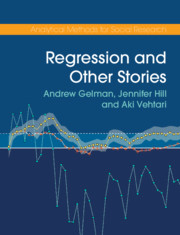Refine search
Actions for selected content:
52383 results in Statistics and Probability
3 - Application ofComputable Distributions to the Semantics of Probabilistic Programs
-
-
- Book:
- Foundations of Probabilistic Programming
- Published online:
- 18 November 2020
- Print publication:
- 03 December 2020, pp 75-120
-
- Chapter
-
- You have access
- Open access
- Export citation
6 - Expected Runtime Analyis by Program Verification
-
-
- Book:
- Foundations of Probabilistic Programming
- Published online:
- 18 November 2020
- Print publication:
- 03 December 2020, pp 185-220
-
- Chapter
-
- You have access
- Open access
- Export citation
12 - Quantitative Information Flow with Monads in Haskell
-
-
- Book:
- Foundations of Probabilistic Programming
- Published online:
- 18 November 2020
- Print publication:
- 03 December 2020, pp 391-448
-
- Chapter
-
- You have access
- Open access
- Export citation
14 - Tabular: Probabilistic Inference from the Spreadsheet
-
-
- Book:
- Foundations of Probabilistic Programming
- Published online:
- 18 November 2020
- Print publication:
- 03 December 2020, pp 489-532
-
- Chapter
-
- You have access
- Open access
- Export citation
10 - Quantitative Equational Reasoning
-
-
- Book:
- Foundations of Probabilistic Programming
- Published online:
- 18 November 2020
- Print publication:
- 03 December 2020, pp 333-360
-
- Chapter
-
- You have access
- Open access
- Export citation
5 - Probabilistic Couplings from Program Logics
-
-
- Book:
- Foundations of Probabilistic Programming
- Published online:
- 18 November 2020
- Print publication:
- 03 December 2020, pp 145-184
-
- Chapter
-
- You have access
- Open access
- Export citation
Contents
-
- Book:
- Foundations of Probabilistic Programming
- Published online:
- 18 November 2020
- Print publication:
- 03 December 2020, pp v-vi
-
- Chapter
-
- You have access
- Open access
- Export citation
7 - Termination Analysis of Probabilistic Programs with Martingales
-
-
- Book:
- Foundations of Probabilistic Programming
- Published online:
- 18 November 2020
- Print publication:
- 03 December 2020, pp 221-258
-
- Chapter
-
- You have access
- Open access
- Export citation
Large complete minors in random subgraphs
- Part of
-
- Journal:
- Combinatorics, Probability and Computing / Volume 30 / Issue 4 / July 2021
- Published online by Cambridge University Press:
- 03 December 2020, pp. 619-630
-
- Article
- Export citation
Frontmatter
-
- Book:
- Foundations of Probabilistic Programming
- Published online:
- 18 November 2020
- Print publication:
- 03 December 2020, pp i-iv
-
- Chapter
-
- You have access
- Open access
- Export citation
11 - Probabilistic Abstract Interpretation: Sound Inference and Application to Privacy
-
-
- Book:
- Foundations of Probabilistic Programming
- Published online:
- 18 November 2020
- Print publication:
- 03 December 2020, pp 361-390
-
- Chapter
-
- You have access
- Open access
- Export citation
9 - The Logical Essentials of Bayesian Reasoning
-
-
- Book:
- Foundations of Probabilistic Programming
- Published online:
- 18 November 2020
- Print publication:
- 03 December 2020, pp 295-332
-
- Chapter
-
- You have access
- Open access
- Export citation
Influenza vaccine failure in the tropics: a retrospective cohort study of waning effectiveness
-
- Journal:
- Epidemiology & Infection / Volume 148 / 2020
- Published online by Cambridge University Press:
- 02 December 2020, e299
-
- Article
-
- You have access
- Open access
- HTML
- Export citation
Two hundred days of COVID-19 in São Paulo State, Brazil
-
- Journal:
- Epidemiology & Infection / Volume 148 / 2020
- Published online by Cambridge University Press:
- 02 December 2020, e295
-
- Article
-
- You have access
- Open access
- HTML
- Export citation

Regression and Other Stories
-
- Published online:
- 01 December 2020
- Print publication:
- 23 July 2020
-
- Textbook
- Export citation
Risk factors for delayed negative conversion of SARS-CoV-2 in patients with COVID-19 pneumonia: a retrospective cohort study
-
- Journal:
- Epidemiology & Infection / Volume 148 / 2020
- Published online by Cambridge University Press:
- 01 December 2020, e293
-
- Article
-
- You have access
- Open access
- HTML
- Export citation
Limit theorems for multi-type general branching processes with population dependence
- Part of
-
- Journal:
- Advances in Applied Probability / Volume 52 / Issue 4 / December 2020
- Published online by Cambridge University Press:
- 03 December 2020, pp. 1127-1163
- Print publication:
- December 2020
-
- Article
-
- You have access
- HTML
- Export citation
APR volume 52 issue 4 Cover and Front matter
-
- Journal:
- Advances in Applied Probability / Volume 52 / Issue 4 / December 2020
- Published online by Cambridge University Press:
- 03 December 2020, pp. f1-f2
- Print publication:
- December 2020
-
- Article
-
- You have access
- Export citation
A neural network model for solvency calculations in life insurance
-
- Journal:
- Annals of Actuarial Science / Volume 15 / Issue 2 / July 2021
- Published online by Cambridge University Press:
- 01 December 2020, pp. 259-275
-
- Article
- Export citation
Mean and variance of balanced Pólya urns
- Part of
-
- Journal:
- Advances in Applied Probability / Volume 52 / Issue 4 / December 2020
- Published online by Cambridge University Press:
- 03 December 2020, pp. 1224-1248
- Print publication:
- December 2020
-
- Article
- Export citation

